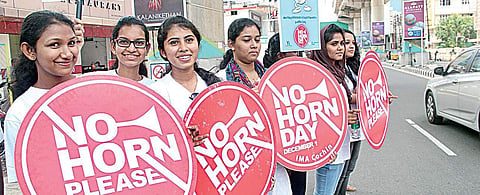

Noise proves nothing. Often a hen who has merely laid an egg cackle as if she laid an asteroid — G Mark Twain (Real name: Samuel Langhorne Clemens), American writer (1835-1910).
Mercifully, the hen lays an egg once a day when it is the season for it. But vehicle drivers on the go or even when stuck in traffic jams, honk their horns incessantly, even when they know that the intended outcome is zero except that they contribute to noise pollution — especially in cities.
There was a time when noise was sign of life. Barry Cornwall, English writer (1787-1874) said: “The sweetest noise on earth, a woman’s tongue; A string which hath no discord.”
But today, noise is viewed differently. As Ambrose Bierce, American writer (1842-1914) noted, “Noise: a stench in the ear. The chief product and authenticating sign of civilisation.” One of the manifestations of civilisation is the motor vehicle. There are two sources of noise in an automobile – the engine and the horn. Knowing the harmful aspects of noise, laws and rules governing motor vehicles have made provisions in this respect. First, the legal position under The Central Motor Vehicles Act, 1988:
Reduction of Noise
119. Horns
(1) Every motor vehicle shall be fitted with an electric horn or other device conforming to the specifications of the Bureau of Indian Standards for use by the driver of the vehicle and capable of giving audible and sufficient warning of approach and position of the vehicle.
(2) No motor vehicle shall be fitted with any multi-toned horn giving a succession of different notes or with any other sound-producing device giving unduly harsh, shrill, loud or alarming noise.
120. Silencers
(1) Every motor vehicle shall be fitted with a device (silencer) which by means of an expansion chamber or otherwise reduces as far as practicable, the noise that would otherwise be made by the escape exhaust gases from the engine.
Then there are State rules like under Karnataka Motor Vehicles Rules, 1989:
221. Restriction on Use of Sound Signals
(1) No driver of a motor vehicle shall sound the horn or other device for giving audible warning with which the motor vehicle is equipped, or shall cause or allow any other person to do so needlessly or continuously or to an extent beyond that which is necessary to ensure safety. Against the laws and rules cited above, what we see (or hear) is blatant misuse of horns by drivers. On the other hand, the use of horns by drivers to carve out right of way (overtaking) is beyond the scope of, and contrary to, the Acts and Rules cited above. If traffic police or RTO do not book such violations, they are either ignorant of legal provisions or inefficient to enforce them or have their personal hidden agenda to collude with the violators. It may be argued that the vehicles are too numerous and violations are so frequent that it is impossible to bring violators to book.
Against this background, I am presenting here a novel idea to encash horn violations. Drivers can be disciplined by installing horn metres which cumulatively register the noise generated by the horn. This should be monitored periodically (say once a month in a booth on the petrol bunk) and charged on a graduated slab rate — like in the case of Income Tax — after giving an initial free allowance for use of horn for safety and warning purposes. While the vehicle owner is obviously the person to pay for the metered amount, it should be possible for him to recover the whole or part of the amount from the horn-crazy driver. That would put the fear of the devil in him the next time he is tempted to extend his itchy hand towards the horn.
How does one collect such tax? Pollution certificate issuers can do the periodic reading and tax collecting (against a certain percentage commission) entity. Such honk metres should be compact and detachable for recording. This is within the current trend of electronic recording. The electric and piped water meter reader uses a hand-held machine to read on-site meters and issue bills. Issuing bus tickets has been widely mini-computerised. So, the idea of horn metres is not far-fetched, but feasible and would be an additional weapon to control noise pollution through excessive and erratic use of horns. If this is done, three birds can be killed with one stone — revenue for State, noise relief to citizens and well-deserved punishment for offending honk-maniacs.
